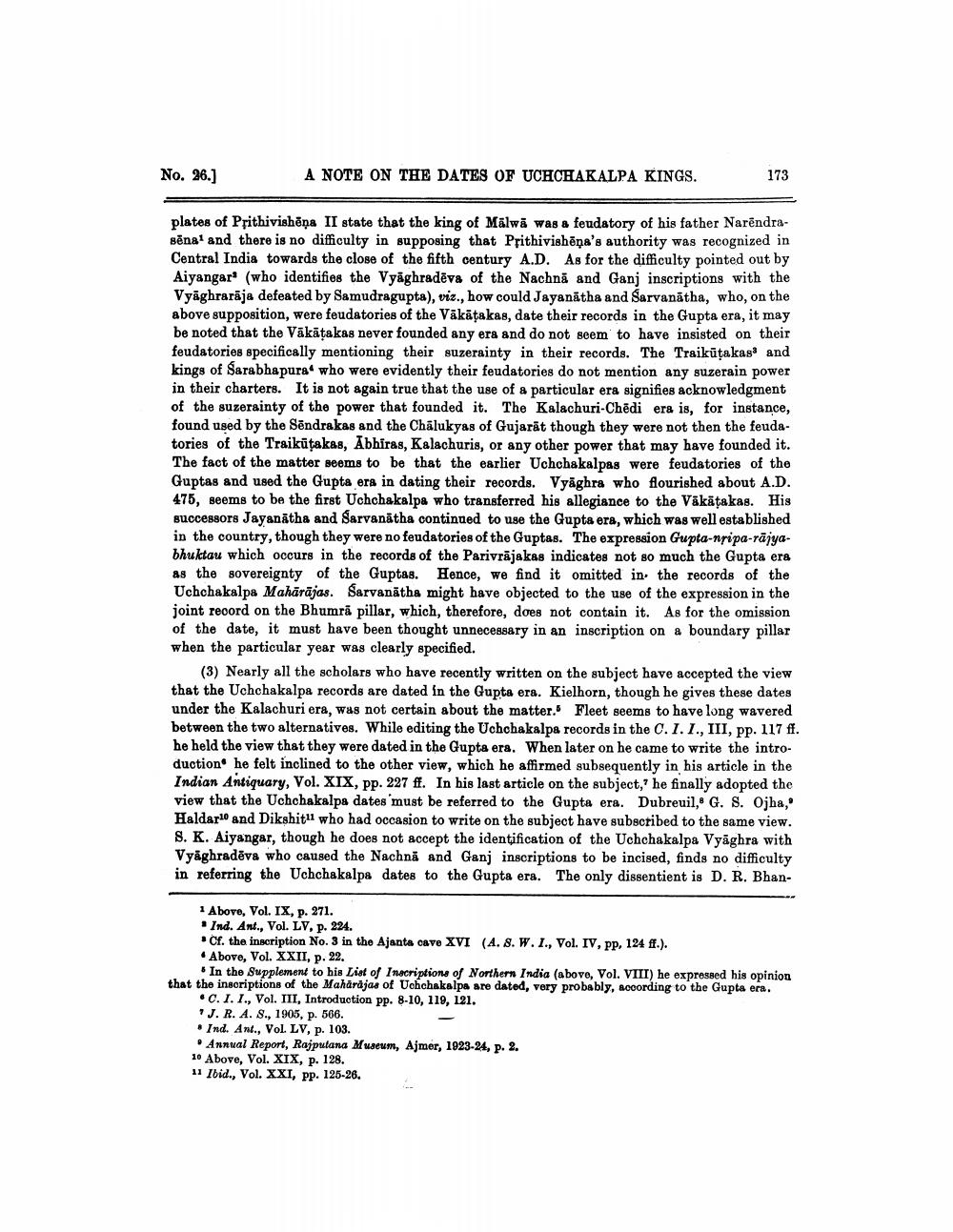________________
No. 26.]
A NOTE ON THE DATES OF UCHCHAKALPA KINGS.
173
plates of Prithivishēņa II state that the king of Malwa was a feudatory of his father Narendrasēna1 and there is no difficulty in supposing that Prithivishēņa's authority was recognized in Central India towards the close of the fifth century A.D. As for the difficulty pointed out by Aiyangar (who identifies the Vyaghradeva of the Nachna and Ganj inscriptions with the Vyaghrarāja defeated by Samudragupta), viz., how could Jayanatha and Sarvanatha, who, on the above supposition, were feudatories of the Vākāṭakas, date their records in the Gupta era, it may be noted that the Vākāṭakas never founded any era and do not seem to have insisted on their feudatories specifically mentioning their suzerainty in their records. The Traikuṭakas and kings of Sarabhapura who were evidently their feudatories do not mention any suzerain power in their charters. It is not again true that the use of a particular era signifies acknowledgment of the suzerainty of the power that founded it. The Kalachuri-Chedi era is, for instance, found used by the Sendrakas and the Chalukyas of Gujarat though they were not then the feudatories of the Traiküṭakas, Abhiras, Kalachuris, or any other power that may have founded it. The fact of the matter seems to be that the earlier Uchchakalpas were feudatories of the Guptas and used the Gupta era in dating their records. Vyaghra who flourished about A.D. 475, seems to be the first Uchchakalpa who transferred his allegiance to the Vākāṭakas. His successors Jayanatha and Sarvanatha continued to use the Gupta era, which was well established in the country, though they were no feudatories of the Guptas. The expression Gupta-nripa-rājyabhuktau which occurs in the records of the Parivrajakas indicates not so much the Gupta era as the sovereignty of the Guptas. Hence, we find it omitted in the records of the Uchchakalpa Mahārājas. Sarvanatha might have objected to the use of the expression in the joint record on the Bhumra pillar, which, therefore, does not contain it. As for the omission of the date, it must have been thought unnecessary in an inscription on a boundary pillar when the particular year was clearly specified.
(3) Nearly all the scholars who have recently written on the subject have accepted the view that the Uchchakalpa records are dated in the Gupta era. Kielhorn, though he gives these dates under the Kalachuri era, was not certain about the matter. Fleet seems to have long wavered between the two alternatives. While editing the Uchchakalpa records in the C. I. I., III, pp. 117 ff. he held the view that they were dated in the Gupta era. When later on he came to write the introduction he felt inclined to the other view, which he affirmed subsequently in his article in the Indian Antiquary, Vol. XIX, pp. 227 ff. In his last article on the subject," he finally adopted the view that the Uchchakalpa dates must be referred to the Gupta era. Dubreuil, G. S. Ojha,' Haldar10 and Dikshit" who had occasion to write on the subject have subscribed to the same view. S. K. Aiyangar, though he does not accept the identification of the Uchchakalpa Vyaghra with Vyaghradeva who caused the Nachna and Ganj inscriptions to be incised, finds no difficulty in referring the Uchchakalpa dates to the Gupta era. The only dissentient is D. R. Bhan
1 Above, Vol. IX, P. 271.
Ind. Ant., Vol. LV, p. 224.
Cf. the inscription No. 3 in the Ajanta cave XVI (A. S. W. I., Vol. IV, pp. 124 ff.).
Above, Vol. XXII, p. 22.
In the Supplement to his List of Inscriptions of Northern India (above, Vol. VIII) he expressed his opinion that the inscriptions of the Maharajas of Uchchakalpa are dated, very probably, according to the Gupta era.
C. I. I., Vol. III, Introduction pp. 8-10, 119, 121.
J. R. A. S., 1905, p. 566.
Ind. Ant., Vol. LV, p. 103.
Annual Report, Rajputana Museum, Ajmer, 1923-24, p. 2.
10 Above, Vol. XIX, p. 128.
11 Ibid., Vol. XXI, pp. 125-26.




